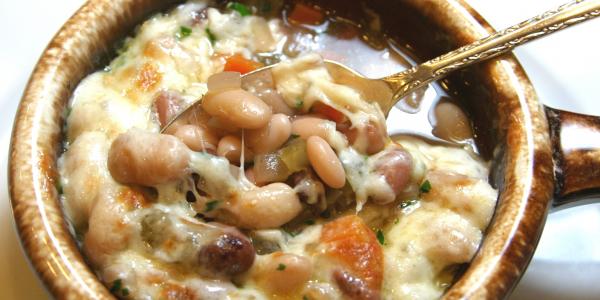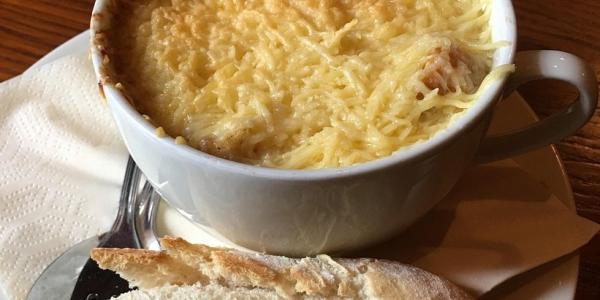Michigan Bean Stew

Ingredients
- 12 oz. dry Michigan bean blend*
- 2 T. olive oil
- 2 c. medium-dice mirepoix:
- 1 c. medium-dice yellow onion
- ½ c. medium-dice carrots
- ½ c. medium-dice celery
- 4 ½ c. low sodium vegetable stock or broth
- 1 T. minced fresh garlic
- 2 T. chopped flat leaf parsley
- 1 T. course ground black pepper
- Salt as needed
- 7 slices provolone cheese
Preparation
Pick out damaged beans, stones and other foreign matter. Rinse beans well. Place in large pot with 8 cups of water. Cover and refrigerate for 8 hours or overnight. Drain beans in a colander and rinse until water runs clear.
Rinse and dry pot and place over medium heat. Add oil; wait until oil gets warm then add mirepoix and cook gently for about 5 minutes. Add soaked beans, stock or broth and garlic. Bring to simmer then reduce heat to low to keep the pot simmering for about 1 hour. Test beans for doneness. Continue cooking as needed.
When beans are tender to your liking, add parsley and pepper. Add salt to taste. Transfer to large cast iron skillet and top with slices of provolone cheese.
Place in 400°F oven and bake for 10 minutes or until cheese is bubbling and slightly browned. Remove from oven and serve.
*Michigan Bean Blend: Combination of any of the following beans grown in Michigan: Azuki, Black, Cannellini, Cranberry, Great Northern, Red Kidney, Navy, Pinto, Small Red Bean, and Yellow Eye Bean
Learn More About Mirepoix
“First, make a mirepoix.” It’s the opening line—the “once upon a time”—for classic French cuisine. And it’s simple, really. Mirepoix (pronounced “meer-pwaw”) is a combination of chopped onion, carrot and celery fried gently in butter or olive oil. Cooking over low heat allows the vegetables to release their flavors to become the aromatic foundation for the rest of the dish.
The story begins a little differently for every culture’s cuisine. For instance,
- soffritto, the flavor base for Italian cuisine, is onion, garlic and fennel cooked in olive oil, butter or fat rendered from prosciutto or pancetta.
- sofregit, Spanish for “to underfry” or to fry lightly, starts with onion and tomato gently fried in olive oil, the basis of Catalan cuisine.
- bumbu, the foundation of Indonesian cooking, uses shallot, garlic and chiles cooked in coconut oil.
- refogado, the cornerstone of Portugal’s fare, combines onion, garlic, tomato and hot or mild peppers cooked in lard or olive oil.
- the Cajun trinity, the foundation of Louisiana Cajun and Creole cuisine, uses onion, bell pepper and celery cooked in butter or bacon fat.
You may have noticed that mirepoix and its counterparts each include at least one member of the Allium (onion) family. A traditional mirepoix is half onion (2 parts) in combination with equal parts carrot (1 part) and celery (1 part). Long slow cooking transforms onion’s distinctive flavor from a sulfurous sting to a savory sweetness.
The size you cut the vegetables should be determined by how long the mirepoix will cook. For a quick-cooking sauce, finely diced vegetables are best for releasing their flavors during the short cooking time. A medium-size cut is good for soups and braises whereas mirepoix for a long cooking stock or stew can be chunks of vegetables.
Herbs and spices, or simply salt and pepper, are the signature of each cuisine (or cook)—and make the story memorable.
Featured Recipes

Rhubarb & Strawberry Crisp
Combine tart rhubarb with sweet strawberries, add a streusel topping, and bake until bubbly. Dessert doesn’t get easier—or more classic—than this. Serve warm with a scoop of vanilla ice cream. You’re sure to get rave reviews!

Farro Salad with Grilled Vegetables
Chewy farro grains are delicious in this autumn-y salad. Recipe yields enough for dinner for 2 to 4 with some left for a couple of lunches. To do this, make the base with dressing, farro, and grilled veggies. Add fresh veggies to the base as you go.

Pecan and Dark Chocolate Chip Cookies
Roasting amps up the flavor in everything including pecans. Chef Kurt's attention to detail takes a traditional chocolate chip cookie to another level of yum!

Onion Soup
Onions, the simplest of pantry staples, mingle with butter, broth, and herbs to become luxuriously smooth and delicious. Add "homemade" croutons and a blend of cheeses to make a complete and satisfying meal.





